15 Traditional English Foods: Look for these authentic dishes to try and eat for a tasty meal
If you are planning on visiting London soon and what to experience a traditional meal in the sense of what is really local and authentic, then you should consider these dishes on my short guide below. I’ve had all these dishes and some were very tasty and some an acquired taste, but if you are really on the lookout for what is traditional food from London and most of England, then consider these specialty and local dishes to try in town and most of the country in general.
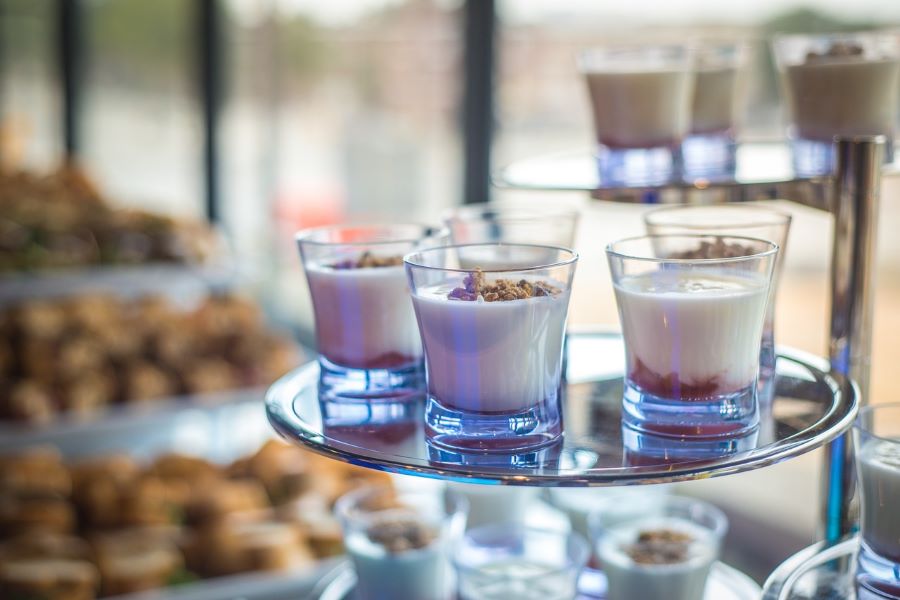
Try these 15 traditional English specialty foods and dishes
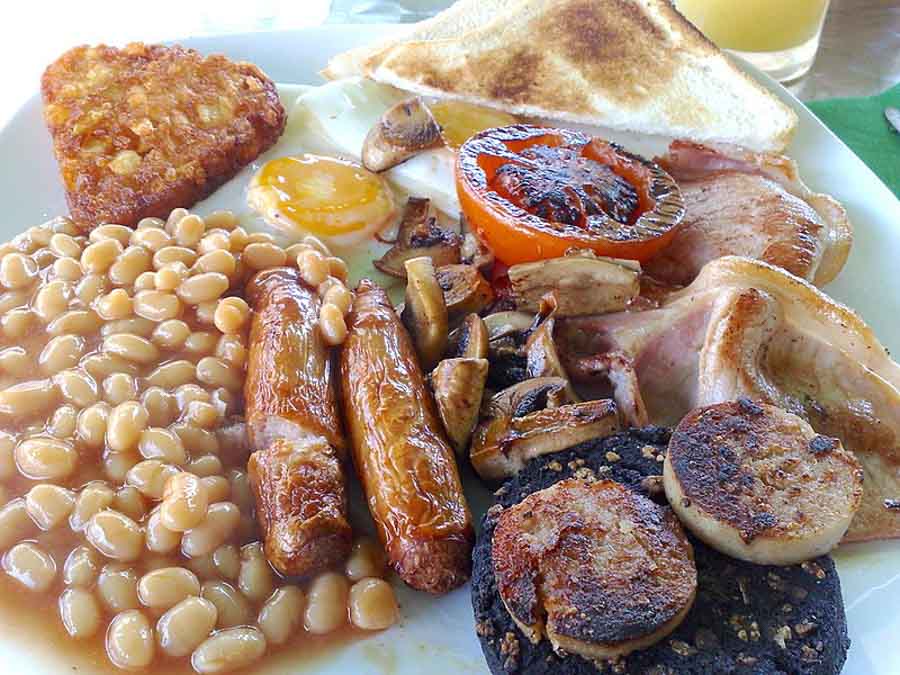
1. Experience an English Breakfast
The British have a genuine affection for their substantial breakfast, and it’s truly a substantial affair. A classic English breakfast comprises crispy bacon, sausages, eggs, either fried or grilled tomatoes, sautéed mushrooms, baked beans, and the inclusion of black pudding. There’s also fried or buttered toast to mop up all that delectable goodness. You can enjoy an English breakfast at hotels and guest houses in London and throughout England. To accompany this hearty meal, a cup of black tea is typically served, providing a robust complement to the substantial feast.
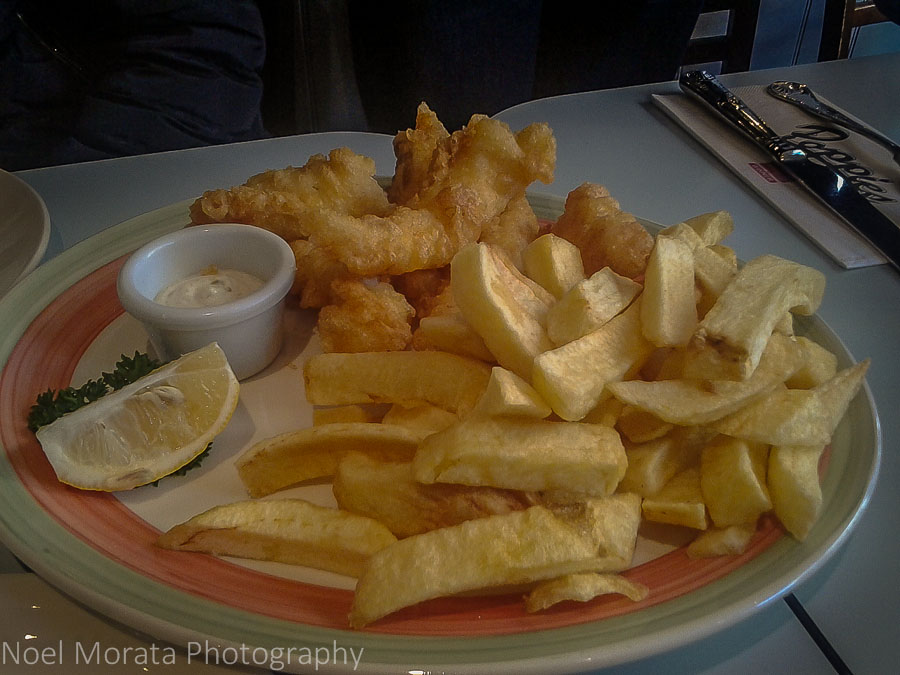
2. A London Fish and Chips experience
London fish and chips is a quintessential British dish that’s cherished for its simplicity and deliciousness. Here’s a description of this classic meal:
1. Fish: London fish and chips traditionally features a generous fillet of white fish, such as cod or haddock. The fish is dipped in a seasoned batter, which is a mixture of flour, water or beer, and a pinch of salt. This batter is the key to the dish’s signature crispy coating.
2. Chips: “Chips” in this context are thick-cut potato fries. These fries are typically made from large potatoes, cut into chunky pieces, and deep-fried to achieve a golden-brown, crispy exterior and a fluffy interior.
3. Serving Style: London fish and chips are often served in a paper or cardboard container, creating a classic and casual takeaway experience. You’ll commonly find it in “fish and chip shops” or “chippies.”
4. Optional Side: It’s not uncommon to serve fish and chips with a side of mushy peas, a quintessential British side dish made from dried marrowfat peas that are soaked, cooked, and then mashed into a soft, slightly lumpy texture. It’s a perfect accompaniment to the crispy fish and chips.
5. Condiments: A classic touch to this meal includes a sprinkling of malt vinegar, a dash of salt, and sometimes a side of tartar sauce for dipping.
6. Tradition: Fish and chips hold a special place in British culinary tradition, dating back to the 19th century. It became especially popular during World War II when it was one of the few foods not rationed, making it an accessible and beloved dish for many.
7. Variations: While cod and haddock are the most common choices for the fish, you can find London fish and chips featuring other fish varieties or seafood like plaice, skate, or even prawns. Some regions in the UK also offer “battered sausage” as an alternative to fish.
London fish and chips is not just a meal; it’s an experience that embodies the simple pleasures of British cuisine. The hot, crispy fish with its tender interior, paired with chunky fries and the condiments of your choice, create a satisfying, timeless, and quintessentially British meal. Whether enjoyed at a traditional fish and chip shop or by the Thames, it’s a dish that resonates with locals and visitors alike.
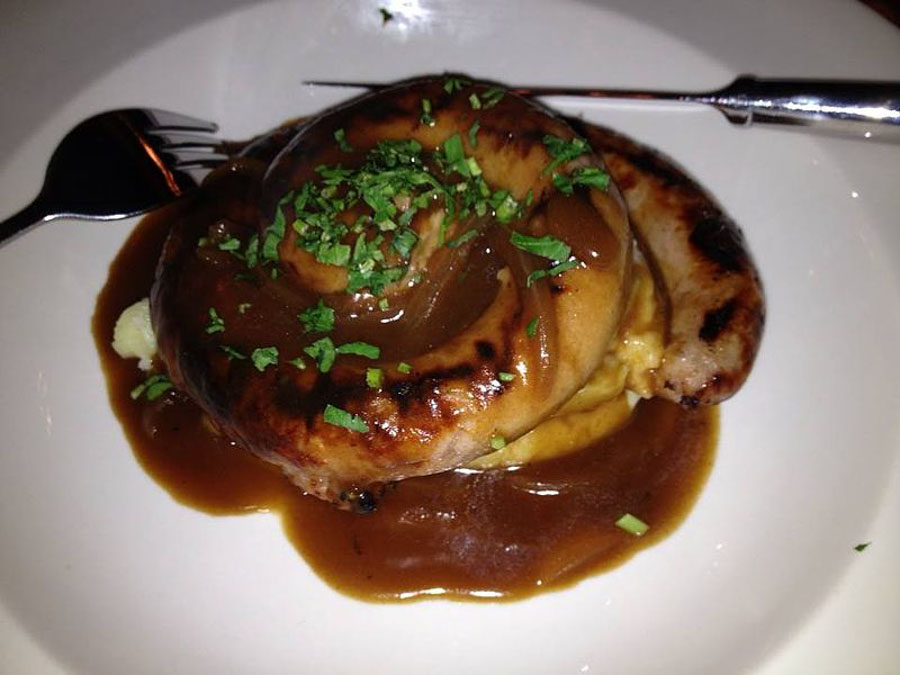
3. Bangers and Mash
Bangers and mash is a beloved British comfort food that’s both hearty and flavorful. This classic dish consists of two main components:
- Bangers: The “bangers” in bangers and mash are sausages, typically pork sausages, although variations with different meats or flavors are also popular. The name “bangers” is said to come from the sausages making a popping or banging sound when they cook due to the high moisture content.
- Mash: The “mash” refers to mashed potatoes, which are creamy and often seasoned with butter and sometimes milk. The mashed potatoes serve as a comforting and velvety bed for the sausages.
The sausages are usually cooked until they’re nicely browned and crispy on the outside. They’re then placed on a plate alongside a generous helping of creamy mashed potatoes. To complete the dish, a rich onion gravy is often poured over the sausages and mashed potatoes, adding depth and flavor to the meal.
Bangers and mash is a satisfying and no-frills meal, often served in pubs and homes across the United Kingdom. It’s the kind of dish that warms the soul on a chilly day and offers a delightful combination of textures and flavors, making it a favorite among both locals and visitors to Britain.
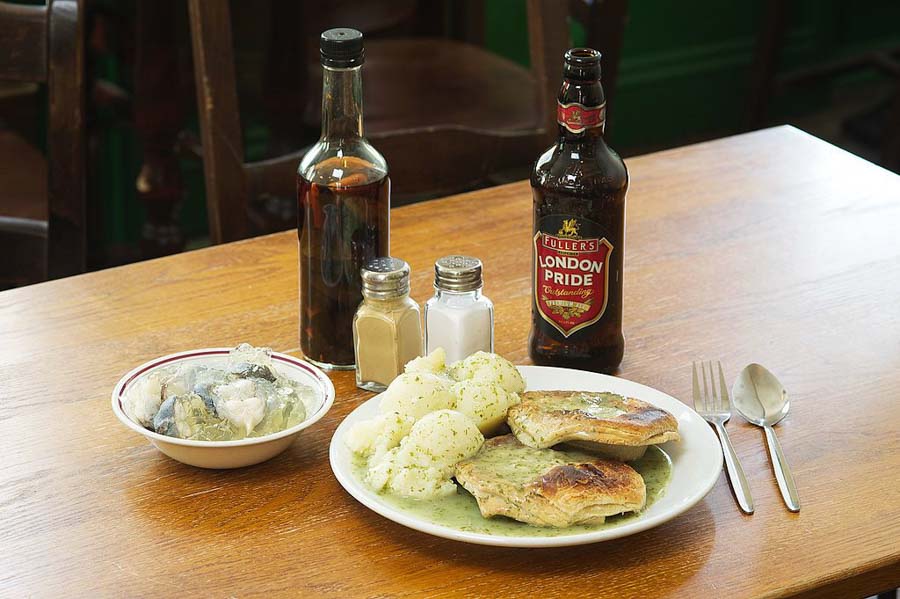
4. Pie Mash and eel liquor
Pie, mash, and eel liquor is a traditional East London dish that has its roots in working-class cuisine. This dish is a unique combination of flavors and textures, and it’s cherished for its hearty and comforting qualities. Here’s a description of each component:
1. Pie: The “pie” in this dish is typically a minced meat pie, traditionally made with minced beef or a mixture of minced beef and minced lamb. The meat is seasoned with a blend of herbs and spices and encased in a pastry crust, creating a flavorful and satisfying filling.
2. Mash: “Mash” refers to mashed potatoes, which are prepared until they are creamy and smooth. These mashed potatoes serve as the base for the pie and create a delightful contrast to the savory meat filling.
3. Eel Liquor: The “eel liquor” is a distinctive green sauce that is made from parsley, eel stock, and a splash of vinegar. It’s a sauce with a tangy and slightly sweet flavor that pairs surprisingly well with the meat pie and mashed potatoes. While the name suggests eels, it’s more about the sauce’s heritage and connection to eel pies that were once popular in East London.
When the dish is served, the minced meat pie is placed on a bed of creamy mashed potatoes, and then a generous amount of the eel liquor sauce is drizzled over the top. The sauce infuses the pie and mashed potatoes with its unique taste, creating a delicious and memorable meal.
Pie, mash, and eel liquor is a nostalgic and comforting dish that has been enjoyed by generations in the East End of London. While it may not be as widely popular as some other British dishes, it’s a beloved part of the city’s culinary heritage and is still available in select traditional pie and mash shops in the area.
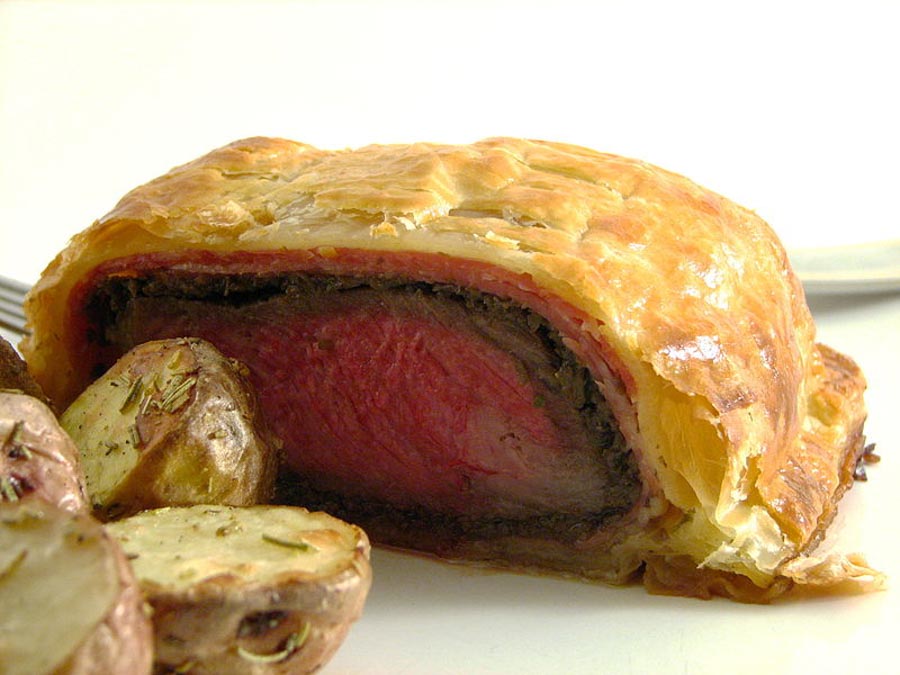
5. Exquisite Beef Wellington
Beef Wellington is a classic British dish that exudes elegance and flavor. This culinary masterpiece is a true showstopper, often reserved for special occasions. Here’s a description of this iconic dish:
1. Beef: At the heart of Beef Wellington is a high-quality beef fillet, such as tenderloin, which is seared to perfection. The beef is seasoned with salt and pepper and sometimes coated with a layer of mustard or mushroom duxelles (a mixture of finely chopped mushrooms, shallots, and herbs).
2. Puff Pastry: The seared beef fillet is then wrapped in a delicate blanket of puff pastry. Puff pastry is a light and flaky dough that puffs up during baking, creating a golden and crisp outer layer.
3. Mushroom Duxelles: A layer of mushroom duxelles is often spread on the puff pastry before the beef is placed, not only to enhance the flavor but also to help keep the pastry from becoming soggy. The duxelles, when cooked, adds a rich umami taste to the dish.
4. Prosciutto or Parma Ham: Some variations of Beef Wellington include a layer of prosciutto or Parma ham between the mushroom duxelles and the beef. This adds a salty, savory element and helps keep the beef moist.
5. Assembly: The beef fillet, sometimes referred to as the “Wellington,” is carefully wrapped in the puff pastry, creating a neat package. The edges of the pastry are sealed, and it’s often adorned with decorative pastry trimmings.
6. Baking: The assembled Beef Wellington is baked in the oven until the pastry becomes golden brown and crisp, and the beef inside reaches the desired level of doneness. It’s essential to achieve the perfect balance: a golden pastry shell and a tender, juicy interior.
7. Serving: Beef Wellington is typically served in thick slices, revealing the beautifully seared beef surrounded by layers of pastry, mushroom duxelles, and, if included, prosciutto. It’s often accompanied by a rich and flavorful sauce, such as a red wine reduction or a velvety mushroom sauce.
Beef Wellington is a labor of love in the kitchen and is known for its sumptuous taste and stunning presentation. It’s a dish that has graced the tables of fine dining establishments and home kitchens alike, making it a classic choice for those looking to impress their guests with a culinary masterpiece.
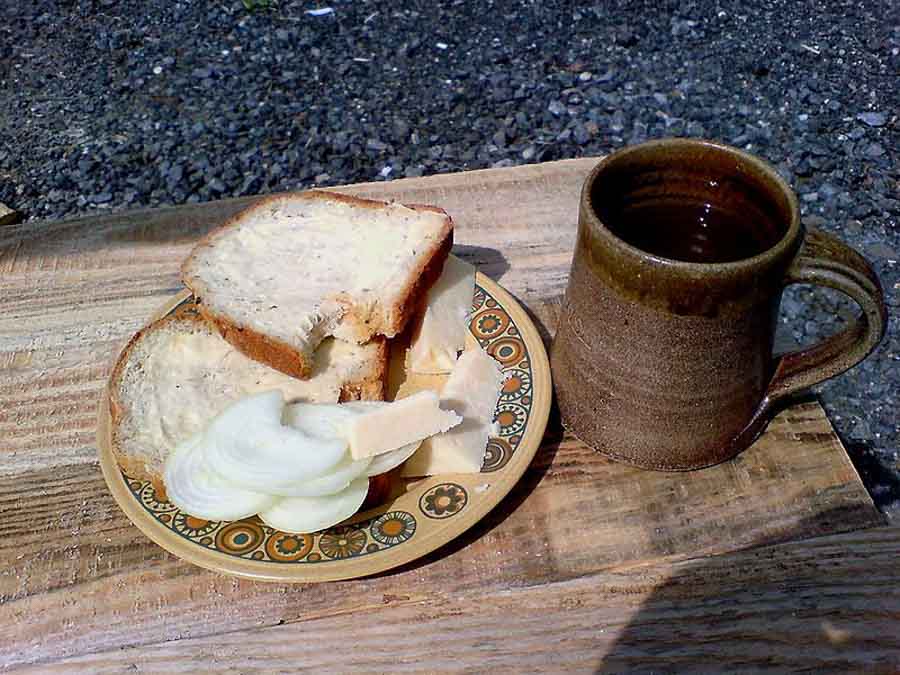
6. Experience a Ploughman’s Lunch
A Ploughman’s Lunch is a traditional and rustic British meal that’s simple, hearty, and bursting with flavors. This dish harkens back to the days when ploughmen (farm laborers) would take their midday meal in the fields. It typically consists of the following components:
1. Cheese: A generous serving of English cheese, often cheddar, is a central element of the Ploughman’s Lunch. The cheese is typically served in thick slices or wedges. Varieties like Stilton or Red Leicester may also be included for added variety.
2. Bread: Slices of crusty bread, often a rustic country loaf or a baguette, accompany the cheese. It’s a key component of the meal and is used for making sandwiches or simply as a side.
3. Pickles: Pickles or pickled onions add a tangy and vinegary element to the dish. They provide a delightful contrast to the richness of the cheese.
4. Cold Meats: Some variations of the Ploughman’s Lunch include cold meats such as ham or slices of roast beef. These meats provide a savory and protein-rich element to the meal.
5. Branston Pickle: Branston Pickle, a sweet and tangy chutney made from a mix of vegetables, vinegar, and spices, is a quintessential condiment for a Ploughman’s Lunch. It’s usually served in a small dish alongside the other components.
6. Fresh Vegetables: Fresh and crisp vegetables like lettuce, tomatoes, cucumber, and radishes are often included, adding a refreshing and crunchy element to the plate.
7. Boiled Eggs: Some versions of the Ploughman’s Lunch feature boiled eggs, which contribute a protein-rich component and a smooth texture.
8. Butter: A pat of butter is typically included for spreading on the bread or serving with the cheese.
9. Apple or Pickled Gherkin: A crisp apple or a pickled gherkin may be added for a touch of sweetness or additional tanginess, depending on personal preference.
The beauty of the Ploughman’s Lunch lies in its simplicity and the opportunity to customize it to your taste. It’s typically served on a wooden platter or a simple plate, allowing you to assemble your ideal bites of cheese, bread, and condiments. It’s a favorite in British pubs and remains a beloved classic, offering a satisfying and well-balanced meal with a variety of flavors and textures.
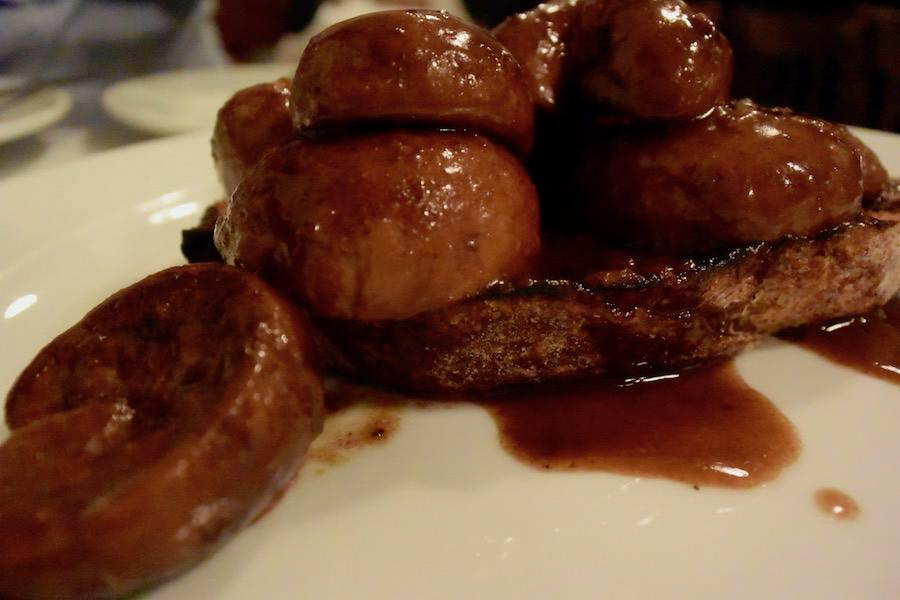
7. Buttery Deviled Kidneys
Buttery Deviled Kidneys is a classic British dish that boasts bold and savory flavors, making it a favorite among those who enjoy offal and hearty comfort food. Here’s a description of this traditional dish:
1. Kidneys: The star of the show is the kidneys, typically lamb or pork kidneys. These are small, organ meats known for their distinctive flavor. Before cooking, the kidneys are usually soaked in milk to help remove any strong or gamey taste.
2. Deviling: The term “deviled” in Buttery Deviled Kidneys refers to the spicy and rich sauce used to coat and flavor the kidneys. This sauce typically includes ingredients such as English mustard, Worcestershire sauce, cayenne pepper, and sometimes a bit of tomato paste. The sauce provides a zesty, tangy, and slightly spicy kick to the dish.
3. Butter: As the name suggests, butter is a key element of this dish. A generous amount of butter is used to sauté the kidneys and create a rich, glossy sauce that’s full of flavor.
4. Toast or Bread: Buttery Deviled Kidneys are often served on toast or slices of crusty bread. The toasty element provides a textural contrast to the tender kidneys and helps soak up the flavorful sauce.
5. Sautéing: The kidneys are quickly sautéed in a hot pan with the butter and deviling sauce, allowing them to cook to the desired level of doneness. The result is tender, slightly pink kidneys with a spicy, buttery coating.
6. Serving: The sautéed kidneys are typically served on the toast or bread, and the rich, spicy sauce is poured over them. This creates a dish that’s both hearty and satisfying.
7. Optional Variations: Some recipes may include additional ingredients like mushrooms or onions for added depth and flavor. The exact recipe can vary, but the heart of the dish remains the kidneys and the deviling sauce.
Buttery Deviled Kidneys is a traditional British dish that may not be as commonly found on modern menus, but it’s beloved by those who appreciate its rich and robust flavors. The dish’s unique combination of tender kidneys, spicy sauce, and buttery richness creates a unique culinary experience that harkens back to the hearty comfort foods of British cuisine.
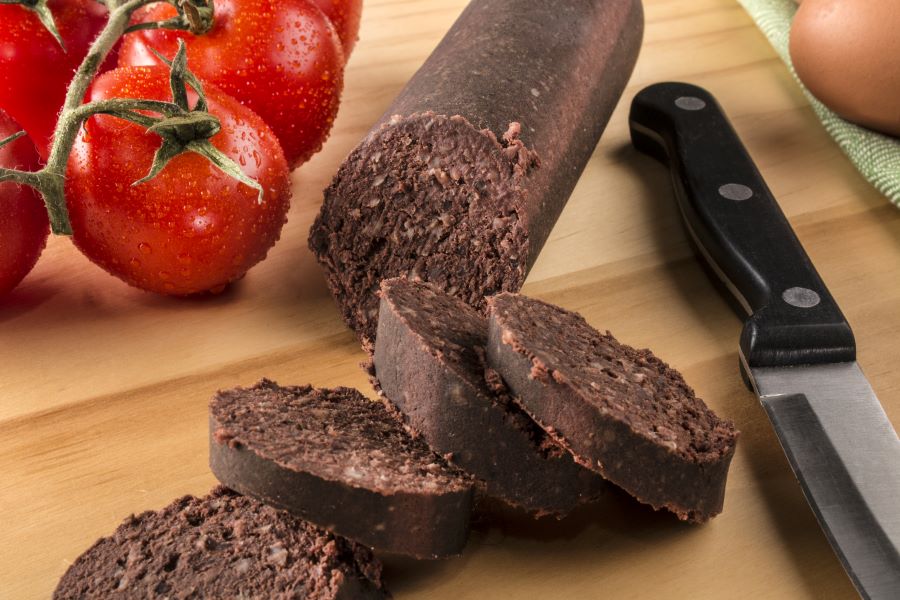
8. English Black Pudding
This is definitely an acquired taste with these black sausages. Black pudding, often referred to as “blood pudding” or simply “pudding,” is a unique and distinctive type of sausage with a history deeply rooted in British and Irish culinary traditions. Here’s a description of black pudding:
1. Ingredients: The primary ingredient in black pudding is animal blood, typically from pigs, though variations using cow’s blood can also be found. The blood is mixed with a filler or binder, which can include ingredients such as oatmeal, barley, or breadcrumbs. These ingredients give black pudding its distinctive texture.
2. Seasonings: To enhance the flavor, black pudding is seasoned with various spices and herbs, which can vary from one region to another. Common seasonings include salt, pepper, and spices like cloves and allspice.
3. Appearance: Black pudding has a dark, nearly black color, which comes from the blood. It’s typically sold in the form of a sausage, with a smooth, firm, and slightly crumbly texture when sliced.
4. Cooking: Black pudding is precooked and can be eaten hot or cold. When served hot, it’s often pan-fried, baked, or grilled. This cooking method crisps up the outer layer while maintaining a soft interior. It’s also a popular component of the traditional full English breakfast.
5. Flavor: Black pudding has a robust and earthy flavor with a deep, savory profile. It has a unique combination of rich, slightly metallic notes from the blood and a hearty, grainy texture from the filler.
6. Versatility: While black pudding is often served as part of a full breakfast, it can also be used in various dishes, including salads, tapas, or as an accompaniment to other meats and vegetables. It’s a versatile ingredient in both traditional and modern cuisine.
Black pudding has a long history in British and Irish culinary traditions and remains a beloved component of regional cuisine. Its strong and distinctive flavor may not appeal to everyone, but for those who enjoy it, black pudding offers a unique and memorable culinary experience.
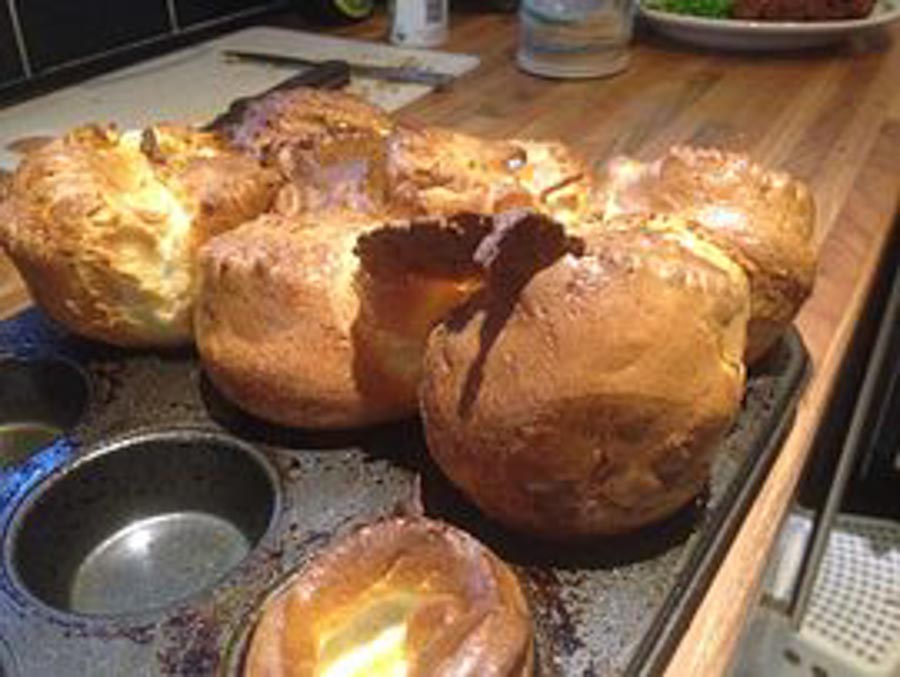
9. Yorkshire Pudding
Yorkshire pudding is a quintessential British dish that’s known for its simplicity and versatility. While the name might suggest a dessert, Yorkshire pudding is, in fact, a savory accompaniment typically served with roast meats, especially roast beef. Here’s a description of Yorkshire pudding:
1. Batter: Yorkshire pudding starts with a simple batter made from basic ingredients: flour, eggs, milk, and a pinch of salt. The batter is typically whisked until it’s smooth and free of lumps.
2. Pan Preparation: To make Yorkshire pudding, you’ll need a specialized baking dish or muffin tin with deep, round wells. These wells are greased with oil or dripping (the fat from the roasted meat) and preheated in the oven until the fat is sizzling hot.
3. Pouring the Batter: Once the fat is hot, the batter is carefully poured into the hot wells of the baking dish. The sizzle as the batter hits the hot fat is a crucial part of achieving the signature rise and texture of Yorkshire pudding.
4. Baking: The dish is returned to the oven and baked at a high temperature, typically around 220°C (425°F), for approximately 20-30 minutes. During this time, the batter transforms into a golden-brown, crispy, and puffy pastry. The edges rise and curl, creating a cup-like shape.
5. Serving: Yorkshire pudding is served hot, often in individual portions. It’s usually served as a side dish alongside a roast dinner, especially roast beef. The hollow center of the pudding is ideal for holding rich gravy, making it an essential component of the traditional Sunday roast.
6. Versatility: While Yorkshire pudding is most famously associated with roast meats, it can also be enjoyed in various ways. For instance, you can serve it as a base for sausages and gravy, creating a dish called “Toad in the Hole.” It’s also a favorite accompaniment for holiday feasts, including Christmas dinners.
Yorkshire pudding is cherished for its comforting, crispy exterior and soft, doughy interior. Its role as a vessel for capturing flavorful gravy is a key part of its appeal, making it an essential element of the classic British roast dinner. Whether served in individual portions or as a large shared pudding, Yorkshire pudding is a beloved part of British culinary tradition.
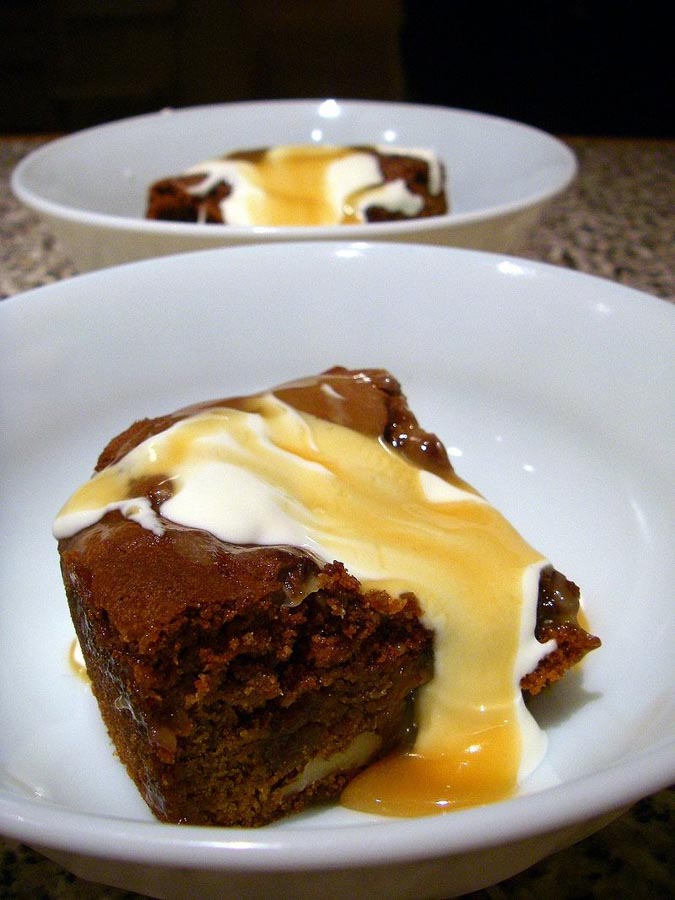
10. Sticky toffee Pudding
Sticky Toffee Pudding is a beloved and indulgent British dessert known for its rich, sweet, and comforting flavors. Here’s a description of this classic treat:
1. Date-Based Pudding: Sticky Toffee Pudding consists of a moist and dense sponge cake made with chopped dates. These dates not only add a natural sweetness but also lend a luscious, caramel-like flavor to the dessert.
2. Toffee Sauce: What sets Sticky Toffee Pudding apart is the luscious toffee sauce. This warm and gooey sauce is rich and buttery, often made with brown sugar, butter, and sometimes a touch of cream. The sauce is usually drizzled generously over the warm pudding, creating a delectable and decadent pairing.
3. Baking: The date-based sponge cake is traditionally baked as individual servings, often in muffin tins or ramekins. The cakes are typically steamed or baked until they are moist and tender, with a slightly sticky texture, which is where the dessert gets its name.
4. Serving: Sticky Toffee Pudding is typically served warm. The warm, toffee sauce is poured over the pudding just before serving, creating a delicious contrast between the soft, warm cake and the rich, velvety sauce.
5. Accompaniments: It’s common to serve Sticky Toffee Pudding with a dollop of clotted cream or a scoop of vanilla ice cream, which adds a cool and creamy element to balance the warmth and sweetness of the dessert.
Sticky Toffee Pudding is a beloved dessert in the United Kingdom, often enjoyed in cozy pubs or as a comforting homemade treat. It’s especially popular during the colder months, as its rich and warm flavors provide a sense of indulgence and comfort. The combination of sweet, moist cake and the luscious toffee sauce creates a dessert that’s as delightful as it is satisfying.
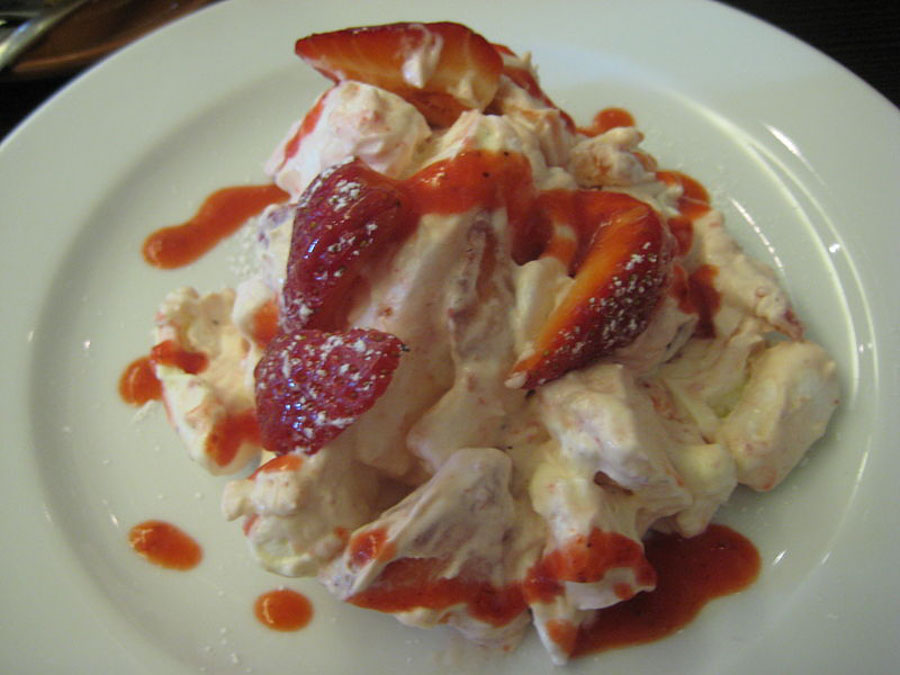
11. Eton Mess – a tasty dessert
Eton Mess is a delightful and quintessentially British dessert that combines a medley of flavors and textures into a delightful, messy, and utterly scrumptious treat. Here’s a description of Eton Mess:
1. Meringues: Eton Mess starts with crisp and sweet meringue nests. Meringues are made from egg whites and sugar, and when baked, they become light and crunchy on the outside while remaining chewy inside.
2. Whipped Cream: The meringues are crumbled into bite-sized pieces and gently mixed with freshly whipped cream. The cream is often lightly sweetened, adding a rich and velvety component to the dessert.
3. Fresh Berries: The star of Eton Mess is the inclusion of fresh, ripe berries, typically strawberries. These vibrant red berries are hulled and sliced or quartered before being gently folded into the creamy mixture. The berries add a burst of natural sweetness and a refreshing, fruity contrast to the richness of the cream and meringues.
4. Assembly: Eton Mess is often casually assembled, creating a “mess” as the name suggests. The crumbled meringues, whipped cream, and berries are layered together or gently mixed in a bowl or glass, resulting in a beautiful and delicious jumble of textures and colors.
5. Optional Additions: While the classic Eton Mess includes these three main components, variations may include additional ingredients such as a drizzle of berry coulis, a sprinkling of crushed nuts, or a touch of vanilla extract in the cream.
6. Seasonal Delight: Eton Mess is especially popular during the British summer when strawberries are in season. Its light and refreshing qualities make it a perfect choice for warm weather.
Eton Mess is believed to have originated at Eton College, one of England’s most prestigious private schools, and has become a beloved dessert enjoyed throughout the United Kingdom and beyond. Its appeal lies in its wonderful contrast of textures, blending the crispness of meringues, the velvety cream, and the burst of fruity goodness from fresh berries. The “mess” is not only in its casual presentation but also in the delightful mingling of flavors that make this dessert a crowd-pleaser.
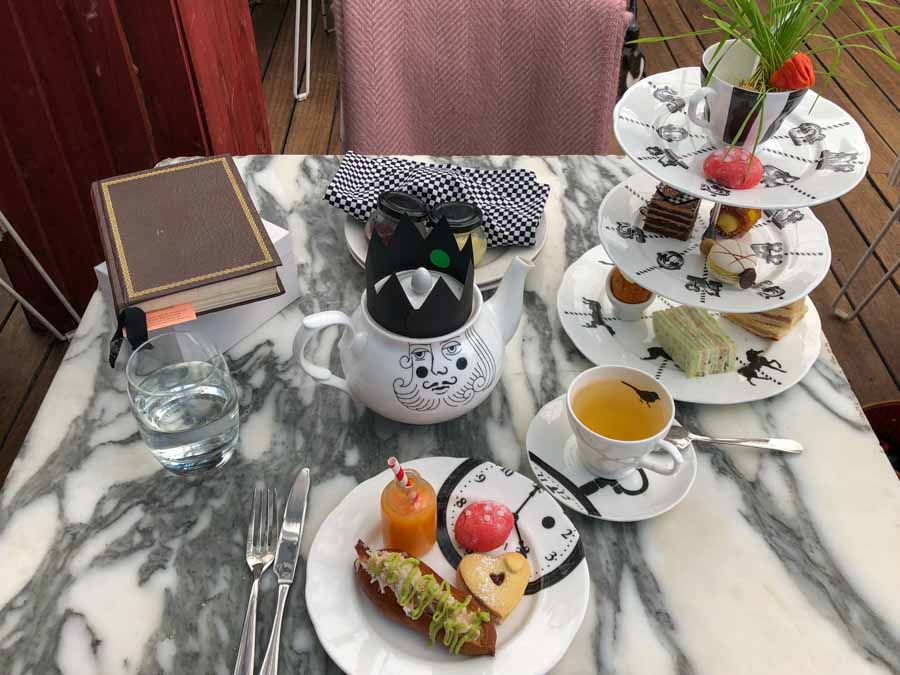
12. A traditional English Tea
A traditional English tea, often referred to as “Afternoon Tea” or “High Tea,” is a delightful and quintessentially British dining experience. It typically consists of several components that create a well-rounded and satisfying meal. Here’s a description of a traditional English tea:
1. Tea: The heart of the experience is, of course, a pot of freshly brewed tea. The tea served is usually black tea, such as Assam, Darjeeling, or Earl Grey. Milk and sugar are typically offered to accompany the tea, allowing each person to customize their tea to their liking.
2. Finger Sandwiches: The meal typically begins with an assortment of delicate finger sandwiches. These sandwiches feature a variety of fillings, including cucumber and cream cheese, smoked salmon, egg and cress, and ham with mustard. The sandwiches are usually served with the crusts removed and cut into small, dainty rectangles or triangles.
3. Scones: Scones are a quintessential part of English tea. They are typically served warm and accompanied by clotted cream and strawberry jam. There are two main types of scones: plain scones and fruit scones, with the latter often containing currants, sultanas, or raisins.
4. Clotted Cream and Jam: Clotted cream, a thick, indulgent cream, is generously spread on the scones, followed by a dollop of strawberry jam. The order in which the cream and jam are added can be a matter of personal preference and varies by region in the UK.
5. Cakes and Pastries: After the sandwiches and scones, a selection of small cakes, pastries, and sweet treats is typically served. These may include Victoria sponge cake, lemon drizzle cake, fruit tarts, éclairs, and petit fours. The array of sweets offers a delightful variety of flavors and textures.
6. Desserts: Some variations of traditional English tea include additional desserts, such as trifle, crème brûlée, or a fruit salad. These offerings add further sweetness and diversity to the meal.
7. Accompaniments: Accompanying the tea and food, you’ll often find a pot of clotted cream, lemon curd, and butter to enhance the scones and other baked goods.
8. Silverware and Fine China: Traditional English tea is often served on elegant fine china and accompanied by silverware, which adds to the sense of occasion and refinement.
9. Presentation: The presentation of an English tea is important. The tiered tea stand, which holds the sandwiches, scones, and pastries, is an iconic part of the experience, creating a visually pleasing and organized arrangement.
10. Atmosphere: The ambiance of a traditional English tea is equally important. It’s often enjoyed in stylish tea rooms, grand hotels, or historic establishments, providing an atmosphere of charm and sophistication.
English tea is not just a meal; it’s a cultural tradition that celebrates the art of taking time to savor small bites and enjoy a soothing cup of tea. It’s a delightful experience that blends a rich history with an appreciation for the finer things in life.
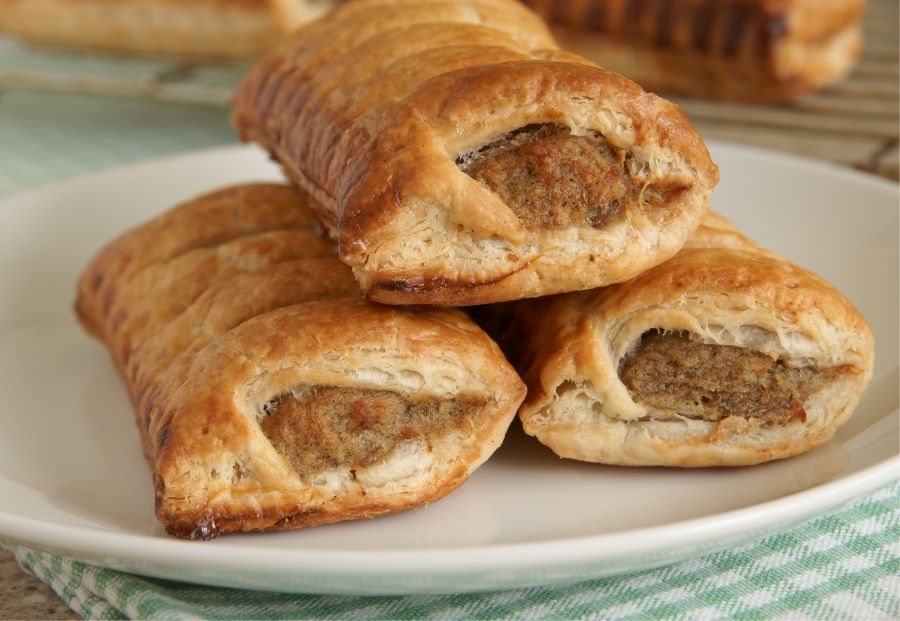
13. English Sausage Rolls
English Sausage Rolls are a beloved and iconic British snack or appetizer known for their savory, flaky pastry and flavorful sausage filling. Here’s a description of this classic treat:
1. Pastry: The foundation of English Sausage Rolls is a sheet of buttery and flaky puff pastry. The pastry is typically rolled out into a rectangular shape, creating a light and crispy casing for the sausage filling.
2. Sausage Filling: The filling is the star of the show and is typically made from seasoned ground pork sausage meat. This sausage meat is often flavored with herbs and spices, which can include thyme, sage, and black pepper. The mixture provides a savory and hearty core for the roll.
3. Assembly: The seasoned sausage meat is shaped into a long, cylindrical log, which is placed on the pastry sheet. The pastry is then folded over the sausage meat, creating a neat and snug encasing. The edges are sealed, and the roll is often brushed with a beaten egg for a glossy finish.
4. Slicing: The assembled roll is sliced into smaller, individual portions. The size of these portions can vary, but they are typically designed to be hand-held and enjoyed as a snack.
5. Baking: The sliced sausage rolls are baked in the oven until the pastry turns golden brown and flaky, and the sausage filling is cooked through, ensuring a juicy and flavorful interior.
6. Serving: English Sausage Rolls are often served warm and can be enjoyed on their own or with a side of condiments. Common accompaniments include ketchup, brown sauce, or a simple English mustard.
7. Versatility: While the classic version features seasoned pork sausage meat, variations of sausage rolls can include different types of meat, such as chicken, beef, or even vegetarian options. Some recipes also incorporate additional ingredients like caramelized onions or cheese for added depth of flavor.
English Sausage Rolls are a popular snack in the UK, enjoyed at picnics, parties, and as a satisfying quick bite. Their winning combination of flaky pastry and savory sausage filling creates a snack that’s not only delicious but also a quintessential part of British culinary culture.
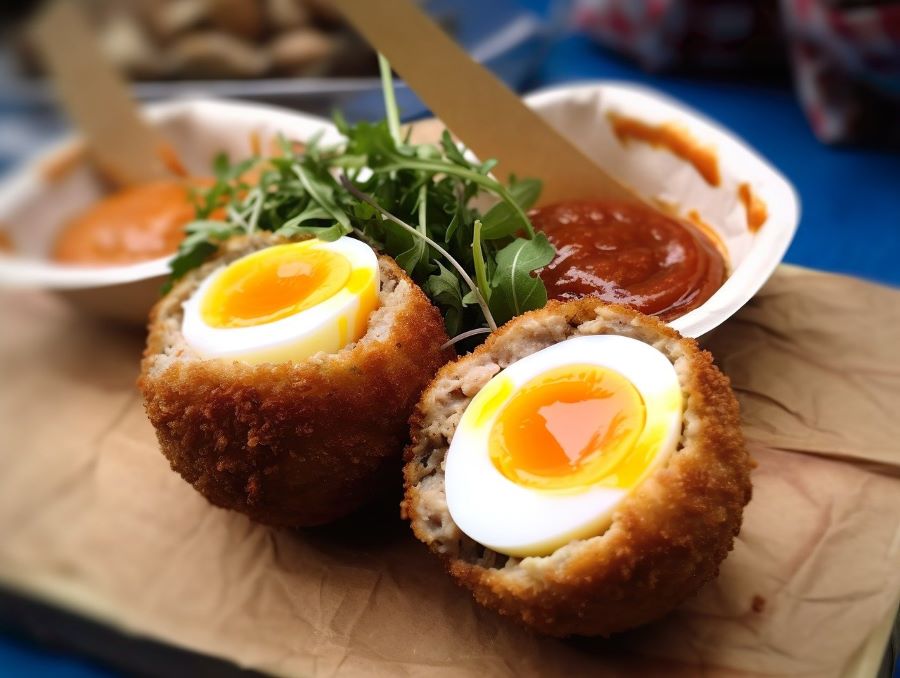
14. Try a Scotch Egg
Scotch eggs are a delightful British snack or appetizer that combines the goodness of a hard-boiled egg with savory sausage meat, creating a flavorful and satisfying treat. Here’s a description of Scotch eggs:
1. Hard-Boiled Egg: The heart of a Scotch egg is a perfectly hard-boiled egg. The egg is typically boiled until the yolk is firm and the white is set, creating a solid and protein-rich core.
2. Sausage Coating: The hard-boiled egg is then encased in a layer of seasoned sausage meat. The sausage meat can be plain pork or flavored with a mix of herbs and spices, which can include salt, pepper, sage, and sometimes a touch of nutmeg. The sausage meat adds a juicy and savory element to the snack.
3. Breading: The sausage-coated egg is then rolled in breadcrumbs, which create a crispy and golden-brown outer layer when the Scotch egg is fried or baked.
4. Cooking: Scotch eggs can be cooked through frying or baking. Frying is a popular choice, as it results in a crispy, slightly crunchy coating while ensuring the sausage meat is cooked thoroughly. Baking is another option for a slightly lighter variation.
5. Serving: Scotch eggs are typically served at room temperature, making them an ideal picnic or on-the-go snack. They are often sliced in half to reveal the hard-boiled egg center and the flavorful sausage meat that surrounds it.
6. Variations: While the classic Scotch egg features pork sausage and breadcrumbs, there are numerous variations to explore. Some may include different types of meat, such as chicken or black pudding sausage meat. Vegetarian versions can also be found, replacing the meat with ingredients like black beans or quinoa.
7. Condiments: Scotch eggs can be enjoyed with a variety of condiments, including ketchup, brown sauce, mustard, or a spicy chutney. The condiments add an extra layer of flavor and a touch of personal preference to the snack.
Scotch eggs are a beloved and timeless snack in the UK, enjoyed in pubs, at picnics, and as a convenient hand-held treat. Their combination of a hard-boiled egg’s wholesome goodness and the savory sausage meat’s richness creates a delightful fusion of flavors and textures that makes them a classic and cherished part of British culinary culture.
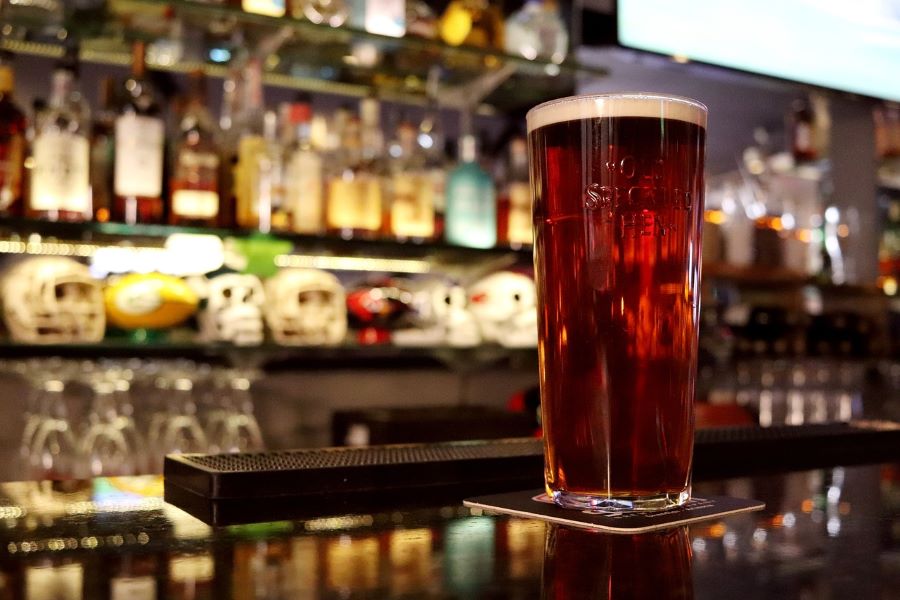
15. A pint of English Beer
A pint of English beer is traditionally served in a standard pint glass, which holds approximately 20 fluid ounces (568 milliliters) of beer. This generous serving size allows beer enthusiasts to enjoy a substantial amount of their favorite brew.
The type of beer you’ll find in an English pub can vary widely. England is known for its diverse beer culture, with a range of beer styles to choose from. Some popular options include bitters, ales, stouts, porters, and lagers. The specific beer on tap can differ from one pub to another.
London Foods and eating FAQ
What is the most popular take away food in London?
Fish and Chips: This classic British dish features deep-fried battered fish (usually cod or haddock) served with thick-cut fries (chips) and often accompanied by mushy peas and tartar sauce. You can find excellent fish and chips in many pubs and restaurants across the city.
What kind of food should you try in London?
You can try a full English breakfast, fish and chips, Shepards pie, Toad in the Hole, Pie and Mash, Bangers and Mash and a delicious afternoon tea in the many fun eating venues around town.
What is the most popular dish in the UK?
Surprisingly the most popular dish in the UK is not a traditional English dish but Indian food and Chicken Tikka Masala as the most popular dish in a nationwide survey done.
What’s the difference between “British” and “English” food?
British” food encompasses dishes from all four UK countries (England, Scotland, Wales, and Northern Ireland), while “English” food specifically refers to dishes originating in England.
What are some vegetarian options in English cuisine?
Vegetarian options include dishes like Vegetable Wellington, Bubble and Squeak, and various vegetarian pies. You can also find vegetarian versions of traditional meals, such as a Full English Breakfast without meat.
What’s the origin of the Yorkshire Pudding?
Yorkshire Pudding is a classic English accompaniment, typically served with roast meats. It originated in Yorkshire, England, and was traditionally used to stretch a small amount of meat into a larger meal.

Check out these other posts on visiting London
25 cool and fun places to visit in London
Eating London – a delicious food tour
Cool attractions in the Southbank of London
Conclusion to trying these 15 traditional English foods
In conclusion, embarking on a culinary journey to try the traditional foods of England is a delightful and flavorful experience. This city, with its rich history and diverse population, offers a culinary tapestry that’s as varied as its neighborhoods. From the beloved classic of fish and chips to the exquisite Indian curries, hearty meat pies, and elegant afternoon teas, London’s food scene is an adventure waiting to be savored.
Exploring around England, and restaurants provides not only a taste of traditional British cuisine but also a glimpse into the vibrant multicultural influences that have shaped the country’s gastronomy. Whether you’re indulging in a classic roast dinner at a cozy pub or relishing the diverse street food options, your palate is in for a treat.
England’s food culture is a reflection of its dynamic and ever-evolving identity, and trying its traditional foods is a window into the heart and soul of this metropolis. So, when you visit England, be sure to take a bite out of its culinary heritage, and savor the flavors that have made this city a global gastronomic destination. Your taste buds will thank you for the adventure.
.

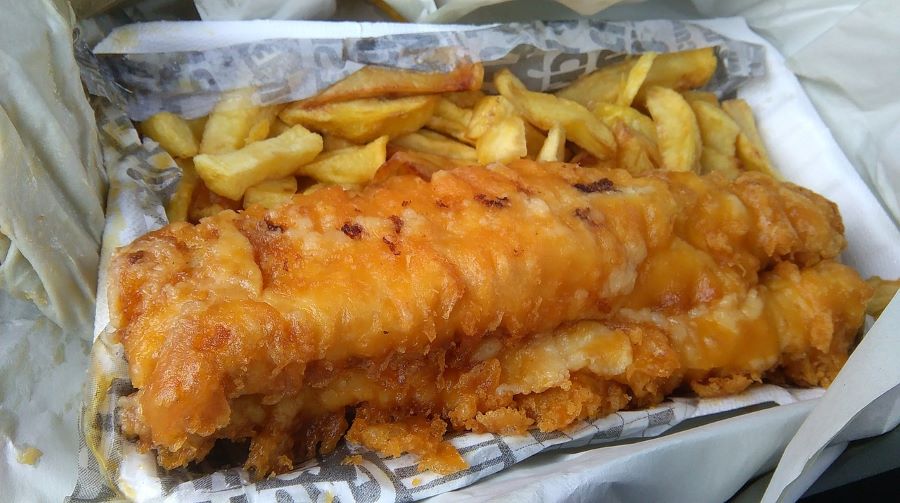

First- love this post! In the future: The ad on the left side is awful. You can’t read the post, the first few words of every sentence on the left.
thanks for the comment and the suggestion on the post on Traditional English Foods, appreciate it